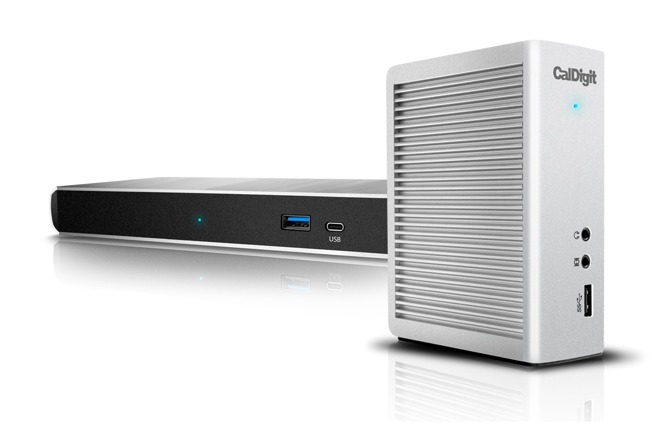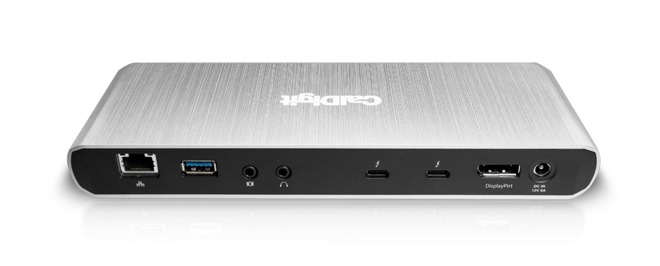CalDigit launches Thunderbolt Station 3 dock with dual 4K support, Lite model
CalDigit's follow-up to the Thunderbolt Station 2 dock consists of two docks, with one aimed at providing expansion over Thunderbolt 3, while the higher-specification version intended for providing charge to MacBooks and legacy drive connections.


The Thunderbolt Station 3 Lite is a slim and wide unit that offers users a pair of Thunderbolt 3 ports with 40Gb/s bandwidth and support for daisy-chaining devices, as well as two USB 3.1 Type-A connections and a single USB 3.1 Type-C port. Able to support dual 4K monitors or a single 5K screen, it also has a full-size DisplayPort, Gigabit Ethernet, and separate audio inputs and outputs.
While it is not meant for charging any of Apple's portables, the dock can still offer up to 15 watts of power to peripherals and connected devices.
Aimed at professionals, the Thunderbolt Station 3 resembles the previous model instead of taking the Lite edition's flatter appearance. While it offers the same two Thunderbolt 3 ports as the Lite, notably this version can provide up to 85W of power, making it suitable to recharge a MacBook Pro.
Three USB 3.1 Type A connections are available to use this time, leaving out the USB 3.1 Type-C from the Lite, with it also including a DisplayPort, Gigabit Ethernet, and audio connections. There are also two eSATA ports included, giving more options for connecting external storage.
The Thunderbolt Station 3 Lite is shipping early in the first quarter of 2017, and is available for pre-order for $169.99, with a regular price of $199.99. The Thunderbolt Station 3, expected to arrive later in the first quarter, will cost $249.99 but can be pre-ordered for $199.99.
CalDigit will likely face stiff competition when the docks ship. Elgato showed off its Thunderbolt 3 Dock earlier this week at CES, as well as new launches by Kanex, Lenovo, and OWC, with Belkin's previously announced Thunderbolt 3 Express Dock HD also making an appearance.

Thunderbolt Station 3 Lite

The Thunderbolt Station 3 Lite is a slim and wide unit that offers users a pair of Thunderbolt 3 ports with 40Gb/s bandwidth and support for daisy-chaining devices, as well as two USB 3.1 Type-A connections and a single USB 3.1 Type-C port. Able to support dual 4K monitors or a single 5K screen, it also has a full-size DisplayPort, Gigabit Ethernet, and separate audio inputs and outputs.
While it is not meant for charging any of Apple's portables, the dock can still offer up to 15 watts of power to peripherals and connected devices.
Thunderbolt Station 3 with MacBook Pro charging, eSATA

Aimed at professionals, the Thunderbolt Station 3 resembles the previous model instead of taking the Lite edition's flatter appearance. While it offers the same two Thunderbolt 3 ports as the Lite, notably this version can provide up to 85W of power, making it suitable to recharge a MacBook Pro.
Three USB 3.1 Type A connections are available to use this time, leaving out the USB 3.1 Type-C from the Lite, with it also including a DisplayPort, Gigabit Ethernet, and audio connections. There are also two eSATA ports included, giving more options for connecting external storage.
The Thunderbolt Station 3 Lite is shipping early in the first quarter of 2017, and is available for pre-order for $169.99, with a regular price of $199.99. The Thunderbolt Station 3, expected to arrive later in the first quarter, will cost $249.99 but can be pre-ordered for $199.99.
CalDigit will likely face stiff competition when the docks ship. Elgato showed off its Thunderbolt 3 Dock earlier this week at CES, as well as new launches by Kanex, Lenovo, and OWC, with Belkin's previously announced Thunderbolt 3 Express Dock HD also making an appearance.

Comments
Totally agree.
These docks are still an intermediate phase - supporting legacy connections. The real usage of the ports on the MBP would be with stuff like the external GPU boxes that you mention.
I also think that all cameras - DSLRs, prosumers and point-and-shoot cameras, should support Bluetooth/ WiFi transfers. It's been over a year and a half since I last bought a camera. That had a convoluted way, wherein the camera becomes a WiFi hub and I needed to connect my phone/ laptop to it and then I could transfer photos across.
I hope things are a lot easier now.
I have a Canon D70 DSLR which has a half baked system that can transfer JPEG only images over wifi (and then zero integration into Photos or Aperture other than manually) but given I only shoot RAW I only tried it once just to see how it worked. Of course iPhones do everything you mention already, perhaps Canon and Nikon would be better off pairing with an iPhone in close proximity via Bluetooth to do the heavy lifting to the cloud rather than trying to reinvent the wheel?